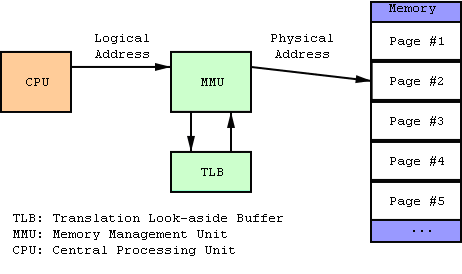A memory management unit (MMU), sometimes called paged memory management unit (PMMU), is a computer hardware component responsible for handling accesses to memory requested by the CPU. Its functions include translation of virtual addresses (By UNL it should be line address, but as following picture it should be Logical Address) to physical addresses (i.e., virtual memory management), memory protection, cache control, bus arbitration, and, in simpler computer architectures (especially 8-bit systems), bank switching.
A PTE or TLB (Translation Look-aside
So PTE or TLB manage Page and maintain page information.
Sometimes, a TLB entry or PTE prohibits access to a virtual page, perhaps because no physical random access memory has been allocated to that virtual page. In this case the MMU signals a page fault to the CPU. The operating system (OS) then handles the situation, perhaps by trying to find a spare frame of RAM and set up a new PTE to map it to the requested virtual address. If no RAM is free, it may be necessary to choose an existing page, using some replacement algorithm, and save it to disk (this is called "paging"). With some MMUs, there can also be a shortage of PTEs or TLB entries, in which case the OS will have to free one for the new mapping.
In some cases a "page fault" may indicate a software bug. A key benefit of an MMU is memory protection: an OS can use it to protect against errant programs, by disallowing access to memory that a particular program should not have access to. Typically, an OS assigns each program its own virtual address space.
An MMU also reduces the problem of fragmentation of memory. After blocks of memory have been allocated and freed, the free memory may become fragmented (discontinuous) so that the largest contiguous block of free memory may be much smaller than the total amount. With virtual memory, a contiguous range of virtual addresses can be mapped to several non-contiguous blocks of physical memory.
Conclusions:
1. MMU is Hardware component.
2. MMU need cooperate with TLB.TLB is mainly for Address translation.
3. "Page fault" may indicate a software bug.
4. Reduces the problem of fragmentation of memor
Following is some things about MMU of PowePc.
PowerPC
In PowerPC G1, G2, G3, and G4, pages are normally 4 KiB. After a TLB miss, the standard PowerPC MMU begins two simultaneous lookups. One lookup attempts to match the address with one of 4 or 8 Data Block Address Translation (DBAT) registers, or 4 or 8 Instruction Block Address Translation registers (IBAT) as appropriate. The BAT registers can map linear chunks of memory as large as 256 MiB, and are normally used by an OS to map large portions of the address space for the OS kernel's own use. If the BAT lookup succeeds, the other lookup is halted and ignored.
The other lookup, not directly supported by all processors in this family, is via a so-called "inverted page table" which acts as a hashed off-chip extension of the TLB. First, the top 4 bits of the address are used to select one of 16 segment registers. 24 bits from the segment register replace those 4 bits, producing a 52-bit address. The use of segment registers allows multiple processes to share the same hash table. The 52-bit address is hashed, then used as an index into the off-chip table. There, a group of 8 page table entries is scanned for one that matches. If none match due to excessive hash collisions, the processor tries again with a slightly different hash function. If this too fails, the CPU traps into the OS (with MMU disabled) so that the problem may be resolved. The OS needs to discard an entry from the hash table to make space for a new entry. The OS may generate the new entry from a more-normal tree-like page table or from per-mapping data structures which are likely to be slower and more space-efficient. Support for no-execute control is in the segment registers, leading to 256-MiB granularity.
A major problem with this design is poor cache locality caused by the hash function. Tree-based designs avoid this by placing the page table entries for adjacent pages in adjacent locations. An operating system running on the PowerPC may minimize the size of the hash table to reduce this problem.
It is also somewhat slow to remove the page table entries of a process; the OS may avoid reusing segment values to delay facing this or it may elect to suffer the waste of memory associated with per-process hash tables. G1 chips do not search for page table entries, but they do generate the hash with the expectation that an OS will search the standard hash table via software. The OS can write to the TLB. G2, G3, and early G4 chips use hardware to search the hash table. The latest chips allow the OS to choose either method. On chips that make this optional or do not support it at all, the OS may choose to use a tree-based page table exclusively.





















 1302
1302











 被折叠的 条评论
为什么被折叠?
被折叠的 条评论
为什么被折叠?








